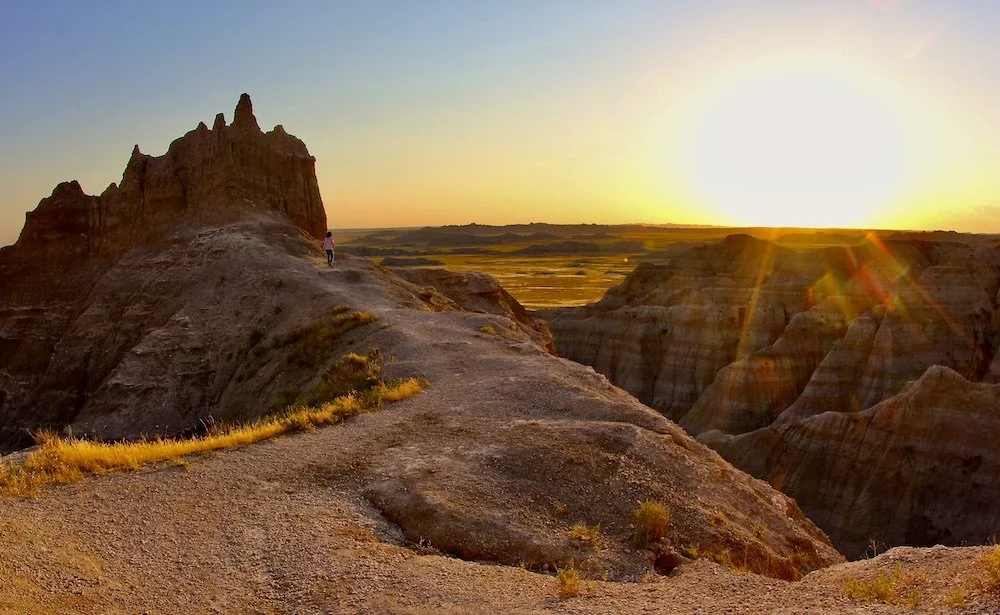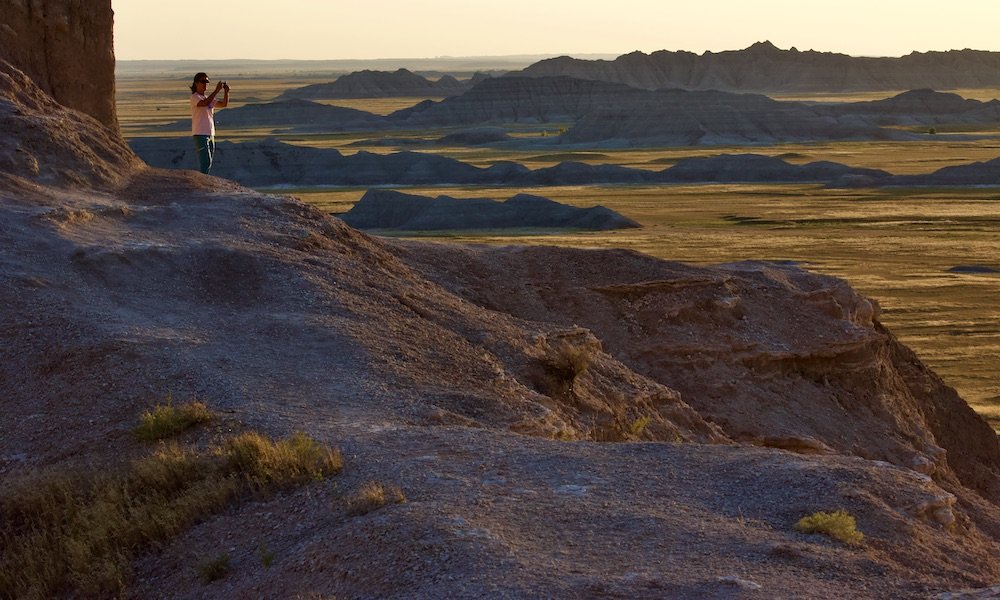Traveling America By Van: Badlands National Park
By: John Kumiski
After an hour's drive from Rapid City on the interstate, we reached Badlands National Park. Bison greeted us first; then the ranger at the park's entrance station did. She gave us a park map, and said, "The first pullout you'll come to is the one for the Pinnacles." We thanked her and drove off, immediately turning the wrong way. Not intentionally, either.
The car was included for a sense of scale.
The first pullout we came to, then, was not the Pinnacles. A bighorn sheep greeted us there, so no harm done. But as we continued, the road was bumpy washboard, dirt. Something didn't feel right. I stopped and looked at the map, closely this time. "Oh, we're going the wrong way," I said. I tried to blame Susan, but she wasn't having any of that. She knows me too well sometimes...
We reversed course and got on the correct road, one that was paved. There was much more traffic. Lots of motorcycles! We behaved like stereotypical tourists, getting out at every pulloff, taking in the sights, getting a few photos, then driving to the next pulloff. Repeat as needed.
The scenery was truly fantastic. You could easily imagine yourself being on the moon. The layers of rocks were all different colors, carved by erosion into steep canyons and spires with sharp, pointy tops.
Most pulloffs had signs telling you a bit about what you were looking at. The rocks were formed by deposition over millions of years. The area was twice the floor of a shallow sea, so the base rocks, siltstone, sandstone, shale, and others, were formed by ocean sediments. The upper layers of rock were largely formed of volcanic ash from eruptions farther west. You can read more about the geology of the park on the park's website.
My wife, celebrating the Badlands.
None of the rocks in the park are very hard (at least as rocks go), so they erode relatively quickly. Rivers and streams carved the soft rock into the extraordinary shapes today's visitors experience. This erosion, whether by streams, downpours, or the relentless wind, exposes lots of fossils.
One of the pullouts had a series of signs telling about the fossils found in the park. Lots of them! The park is one of the most fossil-rich environments in the world. When I read that, I wanted to find one. It became a challenge.
In spite of the heat, we decided to take a hike. There are lots of trails through the backcountry of the park. Enough of riding in the car, already! My goal, kept secret from Susan, was to find a fossil.
The side path I took off the main trail that led me to "my" fossil find.
Our path ran over flat terrain at first. The heat quickly became oppressive. We came to a spot where a side path, cut through some low scrub, led to some small, eroded hills.
I walked through the low scrub, which contained plenty of poison ivy. Susan, wearing shorts, wouldn't follow. She called for me to carry her through, but intent on fossil hunting, I did not hear her.
Finding the fossil only took about five minutes. It appeared to be a femur with several other bones, a little out of reach, exposed in a vertical rock wall. Muttering, "I can't believe I found that," I returned to Susan.
She said, "I wanted you to carry me through the poison ivy." "OK, hop on." She jumped on my back and I piggybacked her through the scrub, then took her to the fossil. She couldn't believe I found it, either. We took a couple photos, then made the sweaty trek back to the mercifully air-conditioned car.
The fossils in question.
People have a long history in the Badlands, as long as the time people have lived in North America. Prior to the "modern" Indians, paleo-Indians camped and hunted here. The area was sacred to the Sioux, who hunted but never lived here. After the defeat of the Indians, the area was opened to American settlement under the Homestead Act.
It was a difficult area in which to earn a living, even as a subsistence farmer. Those who were tough enough to hang on until the 1930s met with the Dust Bowl and waves of ravenous grasshoppers. Most of the sod houses these homesteaders used were abandoned as these people moved on to hopefully greener pastures.
A bighorn sheep on its lookout in the Badlands.
In 1929, Calvin Coolidge authorized Badlands National Monument. The monument was renamed Badlands National Park in 1978.
We came to the park campground. Susan said, "I'd love to camp here." The alternative was to drive an hour back to Rapid City, to stay in the noisy campground we'd already paid for, and drive that same hour back east the next morning. We pulled up to the campground station. A personable young Texan manned it. I asked him, "Whaddya got?" To my surprise there were empty sites, and a shower! We found a site we liked and just like that we were camping in the Badlands. It was another in a string of nights that we paid for two campsites.*
Did I mention the heat? We layed around in the shade inside the van for a few hours, fans running. I might have done some writing for Global Outdoors! We took showers. Hunger forced us to have a light dinner of foods that did not need cooking. After clean-up we went looking for a good place to watch the sun set.
Phone-ographing the sunset.
The spot we chose turned out to be popular- deservedly so! We chatted with other sunset connoisseurs while the earth spun the sun lower and lower. Cameras and phones recorded images. Our star finally sank below the horizon, and the party broke up.
On the way back to the campground we saw both bighorn sheep and white-tailed deer. Sasquatch, however, failed to make an appearance.
Our star almost sits on the horizon, Badlands National Park.
At the campsite, for the evening entertainment we watched an old TV program on my computer. After it ended, I stepped outside to observe the universe. Oh, yes! It was spectacular beyond description. What a fantastic planet we live on! I have to photograph this! It was the last night of the Perseid meteor shower. While I failed to record any falling stars, we watched several brilliant streaks light up the sky.
We made another short hike in the cool of the morning. After that, our time in the incredible, beautiful Badlands was unfortunately over. Another long stint on the road faced us, so we pointed the van towards the rising sun.
The Milky Way, photographed from our campground.
*After we got home I calculated our miles per dollar cost (gasoline only), which came out to just under seven miles per dollar. The 140 extra miles we would have had to drive had we returned to Rapid City would cost us $20 in gasoline, not to mention the two hours of driving time. The Badlands campsite cost us only twelve dollars, so it was actually a money as well as a time saver.
Have you done something interesting outdoors? Join Global Outdoors and write a review to tell everyone about it! We’re building the home for trusted reviews of outdoor experiences, outfitters, and guides.










